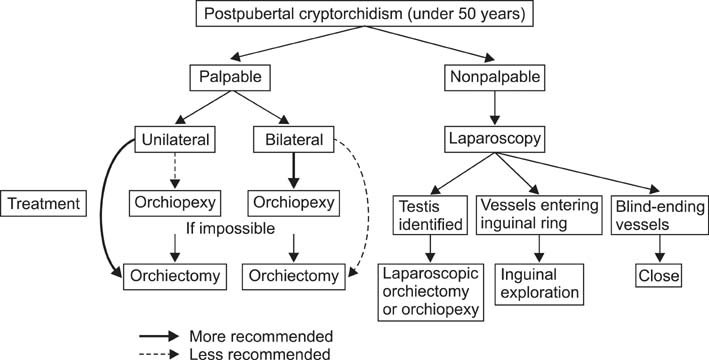World J Mens Health.
2015 Dec;33(3):161-166. 10.5534/wjmh.2015.33.3.161.
Individualized Treatment Guidelines for Postpubertal Cryptorchidism
- Affiliations
-
- 1Department of Urology, Pusan National University School of Medicine, Pusan National University Yangsan Hospital, Yangsan, Korea. lsd@pusan.ac.kr
- 2Research Institute for Convergence of Biomedical Science and Technology, Pusan National University Yangsan Hospital, Yangsan, Korea.
- KMID: 2405143
- DOI: http://doi.org/10.5534/wjmh.2015.33.3.161
Abstract
- Cryptorchidism is a well-known congenital anomaly in children. However, its diagnosis is often delayed for reasons including patient unawareness or denial of abnormal findings in the testis. Moreover, it has been difficult to establish an optimal treatment strategy for postpubertal cryptorchidism, given the small number of patients. Unlike cryptorchidism in children, postpubertal cryptorchidism is associated with an increased probability of neoplasms, which has led orchiectomy to be the recommended treatment. However, routine orchiectomy should be avoided in some cases due to quality-of-life issues and the potential risk of perioperative mortality. Based on a literature review, this study proposes individualized treatment guidelines for postpubertal cryptorchidism.
Keyword
MeSH Terms
Figure
Reference
-
1. Sijstermans K, Hack WW, Meijer RW, van der Voort-Doedens LM. The frequency of undescended testis from birth to adulthood: a review. Int J Androl. 2008; 31:1–11.
Article2. Moradi M, Karimian B, Moradi A. Adult orchidopexy: A survey on necessity of intraoperative testicular biopsy. Nephro Urol Mon. 2011; 3:196–200.3. Barthold JS. Abnormailities of the testis and scrotum and their surgical management. In : Wein AJ, Kavoussi LR, Novick AC, Partin AW, Peters CA, editors. Campbell-Walsh urology. 10th ed. Philadelphia: Saunders;2012. p. 3560–3574.4. Jeong SC, Lee S, Ku JY, Lee SD. Clinical characteristics and treatment of cryptorchidism in adults: a single center experience. World J Mens Health. 2014; 32:110–115.
Article5. Giwercman A, Bruun E, Frimodt-Møller C, Skakkebaek NE. Prevalence of carcinoma in situ and other histopathological abnormalities in testes of men with a history of cryptorchidism. J Urol. 1989; 142:998–1001.
Article6. Coupland CA, Chilvers CE, Davey G, Pike MC, Oliver RT, Forman D. United Kingdom Testicular Cancer Study Group. Risk factors for testicular germ cell tumours by histological tumour type. Br J Cancer. 1999; 80:1859–1863.
Article7. Pettersson A, Richiardi L, Nordenskjold A, Kaijser M, Akre O. Age at surgery for undescended testis and risk of testicular cancer. N Engl J Med. 2007; 356:1835–1841.
Article8. Akre O, Pettersson A, Richiardi L. Risk of contralateral testicular cancer among men with unilaterally undescended testis: a meta analysis. Int J Cancer. 2009; 124:687–689.
Article9. American Academy of Pediatrics. Timing of elective surgery on the genitalia of male children with particular reference to the risks, benefits, and psychopsychological effects of surgery and anesthesia. Pediatrics. 1996; 97:590–594.10. Hutson JM, Hasthorpe S. Abnormalities of testicular descent. Cell Tissue Res. 2005; 322:155–158.
Article11. Toppari J, Kaleva M. Maldescendus testis. Horm Res. 1999; 51:261–269.
Article12. Huff DS, Fenig DM, Canning DA, Carr MG, Zderic SA, Snyder HM 3rd. Abnormal germ cell development in cryptorchidism. Horm Res. 2001; 55:11–17.
Article13. Gotoh M, Miyake K, Mitsuya H. Leydig cell hyperplasia in cryptorchid patients: quantitative evaluation of Leydig cells in undescended and contralateral scrotal testes. Urol Res. 1984; 12:159–164.
Article14. Regadera J, Codesal J, Paniagua R, Gonzalez-Peramato P, Nistal M. Immunohistochemical and quantitative study of interstitial and intratubular Leydig cells in normal men, cryptorchidism, and Klinefelter's syndrome. J Pathol. 1991; 164:299–306.
Article15. Romeo R, Marcello MF. Some considerations on the human Leydig cell (immunohistochemical observations). Arch Ital Urol Androl. 1999; 71:143–148.16. Lee PA, Coughlin MT. Leydig cell function after cryptorchidism: evidence of the beneficial result of early surgery. J Urol. 2002; 167:1824–1827.
Article17. Rogers E, Teahan S, Gallagher H, Butler MR, Grainger R, McDermott TE, et al. The role of orchiectomy in the management of postpubertal cryptorchidism. J Urol. 1998; 159:851–854.18. Grasso M, Buonaguidi A, Lania C, Bergamaschi F, Castelli M, Rigatti P. Postpubertal cryptorchidism: review and evaluation of the fertility. Eur Urol. 1991; 20:126–128.
Article19. Okuyama A, Nonomura N, Nakamura M, Namiki M, Fujioka H, Kiyohara H, et al. Surgical management of undescended testis: retrospective study of potential fertility in 274 cases. J Urol. 1989; 142:749–751.
Article20. Heaton ND, Davenport M, Pryor JP. Fertility after correction of bilateral undescended testes at the age of 23 years. Br J Urol. 1993; 71:490–491.
Article21. Lin YM, Hsu CC, Wu MH, Lin JS. Successful testicular sperm extraction and paternity in an azoospermic man after bilateral postpubertal orchiopexy. Urology. 2001; 57:365.
Article22. Shin D, Lemack GE, Goldstein M. Induction of spermatogenesis and pregnancy after adult orchiopexy. J Urol. 1997; 158:2242.
Article23. Granados Loarca EA, Esau Ortega S. Is necessary to practice orchiectomy in patients with post-puberal maldescended testes? Actas Urol Esp. 2005; 29:969–973.24. Ben Jeddou F, Ghozzi S, Rais NB. Cryptorchidism in adults. About 81 cases. Tunis Med. 2005; 83:742–745.25. Hutson JM, Clarke MC. Current management of the undescended testicle. Semin Pediatr Surg. 2007; 16:64–70.
Article26. Martin DC, Menck HR. The undescended testis: management after puberty. J Urol. 1975; 114:77–79.
Article27. Farrer JH, Walker AH, Rajfer J. Management of the postpubertal cryptorchid testis: a statistical review. J Urol. 1985; 134:1071–1076.
Article28. Oh J, Landman J, Evers A, Yan Y, Kibel AS. Management of the postpubertal patient with cryptorchidism: an updated analysis. J Urol. 2002; 167:1329–1333.
Article29. Herrinton LJ, Zhao W, Husson G. Management of cryptorchism and risk of testicular cancer. Am J Epidemiol. 2003; 157:602–605.
Article30. Kucheria R, Sahai A, Sami TA, Challacombe B, Godbole H, Khan MS, et al. Laparoscopic management of cryptorchidism in adults. Eur Urol. 2005; 48:453–457. discussion 457
Article
- Full Text Links
- Actions
-
Cited
- CITED
-
- Close
- Share
- Similar articles
-
- The Clinical Experience on Orchiectomy in the Postpubertal Unilateral Cryptorchidism
- Comprehension and Practice Patterns Toward Cryptorchidism in Korean Urologists
- The incidence and histological characteristics of intratubular germ cell neoplasia in postpubertal cryptorchid testis
- 5 cases of the Cryptorchidism Treated with Hormonal Therapy (H.C.G.)
- Clinical Characteristics of Mumps in Postpubertal Age


